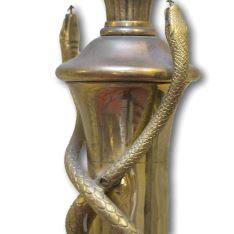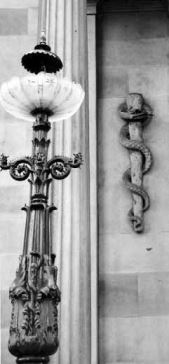
From earliest times snakes, both harmful and harmless, were common in Greek mythology – Zeus himself sometimes appeared as a snake.
Healing snakes were part of the cult of Asclepius, the Greek god of medicine, perhaps because their shedding of old skin symbolised renewed strength and health. Within the Asklepieion at Epidauros are the foundations of a curious circular labyrinth, thought, perhaps, to have been a snake-pit below an elaborate and important building.
The confusion of the rod of Asclepius with the caduceus of Hermes is a common error in medical symbolism. Hermes, a herald, carried as his baton what was at first an olive branch, ending in two shoots twined in a loose knot, and adorned with white ribbons. Over time, the ribbons became two snakes and wings appeared to emphasise his speed as a messenger.
By contrast, Asclepius’s rod, or club, is without wings and entwined by a single snake, as on the plaques on either side of the College’s main door, on the outside of the north wall of the New Library and on the lamp standards outside the College’s entrance. A rod entwined by snakes is carved in each side of the backs of the ceremonial chairs in the Great Hall. The mace and the College Officer’s staff are also entwined by snakes. Golden serpents are also the supporters of the arms of the Royal College of Psychiatrists.




